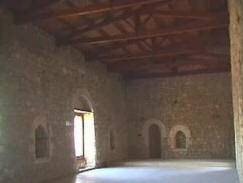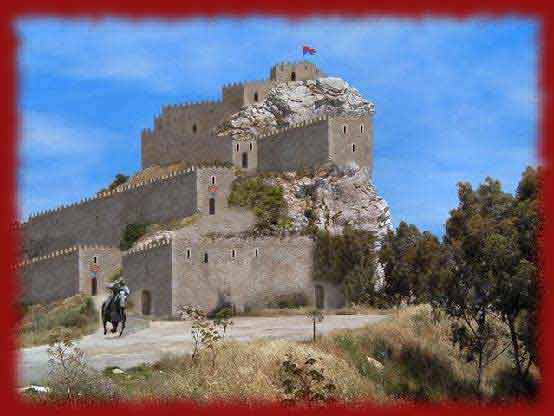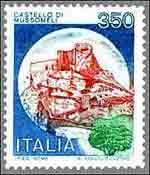


The room of the weapons Portal room some Barons Video: The court of the castle The barons' room



Postage stamp sent forth by the Italian Mails the 22 September 1980 of the series "The Castles of Italy"
A graphic elaboration of the castle as we have performed we imagine once pits.
HISTORY
Then, high up and monumental on a rock, there is
the castle, which dominates Mussomeli and is one of the finest in Sicily.
It is a centuries-old fortress with a decidedly fourteenth-century look, with a
succession of big rooms, tunnels, wells and dungeons, walls with battlements and
weapon rooms, underground rooms, and a chapel in which there are traces of very
old frescoes.
Inauguratet in 1374 by its founder Manfredi Chiaramonte, the edifice is most
imposing on the south side, with merlons and mullioned windows facing the peaks
of the Madonie and looking out on the plateau from atop a precipice.
After the area where there was formerly the drawbridge, you go through a stone
entrance into the stables, a big bay with a tunnel vault.
Some steps lead up to the second door with the blazons of the Lanza family (the
last owners before it became public property).
From here, turning right, you get to the guardrooms and the chapel, where there
are the remains of an altar and the fourteenth-century frescoes.
To the left there opens up the historical Barons' room and then there is the
second level of the castle with other rooms and bays, up to the last room with
the double groin vault roof.
In the underground chambers there is the weapon room and a series of wells and
dungeons. So this is a "Manfredi" castle, a splendid Chiaramonte edifice with
its history and legends. Among these there is the chivalric tale of a jealous
baron who is alleged to have walled up his sisters in the "Three women's room",
a funnel tunnel which can still be seen today: here the three girls were given
provisions meant to be sufficient for the duration of the war, but died of
starvation because the latter went on longer than expected.
Then again, there is the story of the other baron who in the eighteenth century
is said to have conducted from the castle the operations for the capture of the
Pietraperzia bandit Antonino Di Blasi, known as Testalonga ("long head").
There was a grandiose inauguration for the brand new manor, on 16 November 1374.
Manfredi Chiaramonte, who had just been invested) by Frederick III of Aragona
with the seigniory of Castronovo which Mussomeli came under, in the torchlit
castle gave hospitality to Frederick (who had been bereaved of Constance of
Aragona) and his queen Antonia del Balzo. The court arrived with soldiers,
equerries, doctors, cooks, thespians and soothsayers.
With the king and queen, who rested high up where the alcoves wind towards the
hearth room, there was the little Maria, Frederick's daughter from his first
marriage.
In the armoury room there was a crowd of soldiers and other members of the
retinue; the queen's ladies-in-waiting gathered in prayer in the chapel.
Amid the walls with battlements of the keep the sentries guarded the royal
knights.
There were two days of big parades and then the castle went back to its everyday
life.
In 1391 Manfredi organised a meeting of Sicilian barons to resist the Aragonese:
they met in the big Barons' Room, twenty metres by seven, and here swore an oath.
But after that pact they tricked one another, and one by one went over to the
enemy.
The legendary Chiaramonte family declined and a new season began in a lower key.
The castle went from one owner to another and in the sixteenth century was
purchased by Don Cesare Lanza.
The last family to live in the "eagle's nest" was that of Don Ottavio Lanza,
Count of Mussomeli and Baron of Trabia.
Don Ottavio and his ten children held out there on the peak until 1603, but then
moved to their mansion in the centre.
The fortress became a prison, then with the passing of decades was abandoned
even by convicts and slowly declined, while down in the valley the village
changed, and its people began to move in carriages, then in trains, and electric
lighting arrived.
Up there the castle held out, never transformed, never altered in the
manneristic or baroque style.
A few walls collapsed, the roof of the Barons' Room collapsed, marbles and
columns were stolen.
In the early years of the twentieth century the Prince of Trabia entrusted the
restoration project to Ernesto Armò, who gave the castle its present look, ready
to hold out in the twenty-first century.